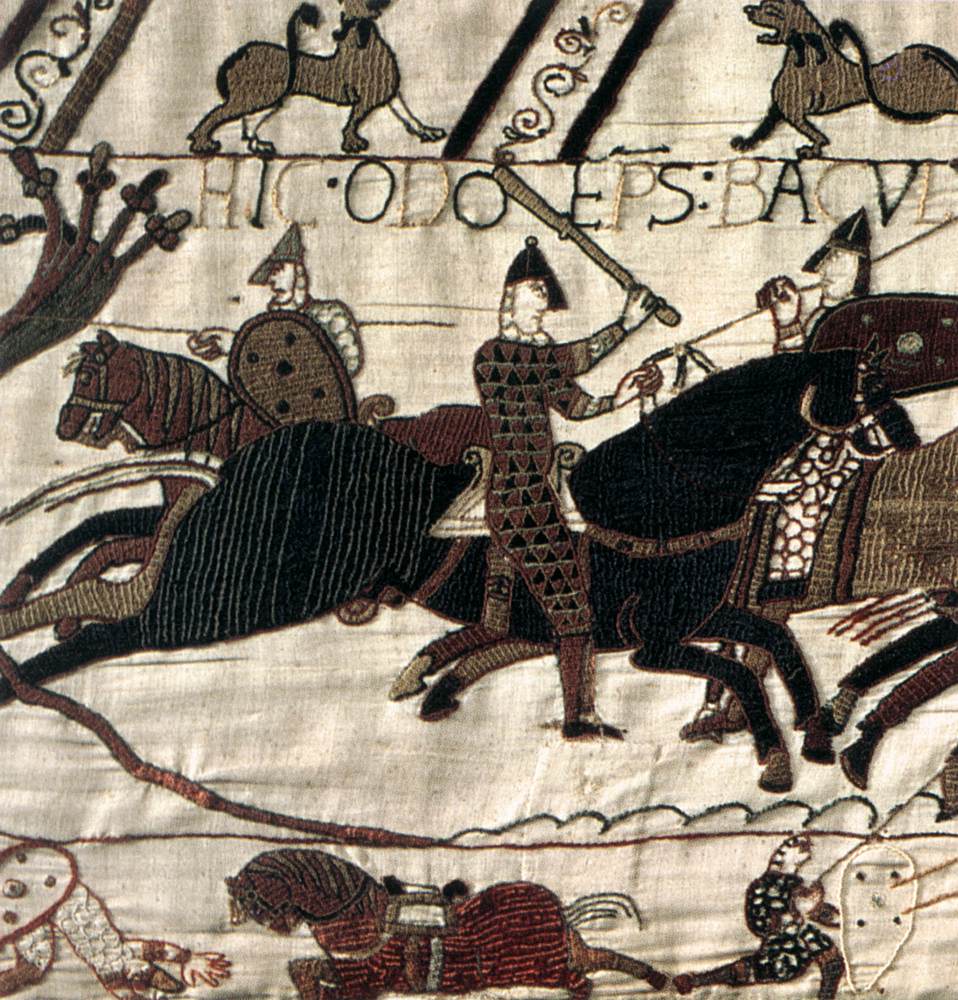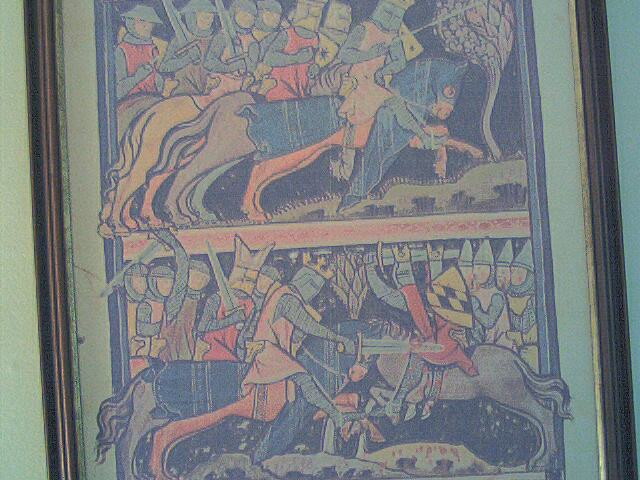
| myArmoury.com is now completely member-supported. Please contribute to our efforts with a donation. Your donations will go towards updating our site, modernizing it, and keeping it viable long-term.
Last 10 Donors: Graham Shearlaw, Anonymous, Daniel Sullivan, Chad Arnow, Jonathan Dean, M. Oroszlany, Sam Arwas, Barry C. Hutchins, Dan Kary, Oskar Gessler (View All Donors) |
| Author |
Message |
|
John Cunningham
Location: United States Joined: 19 Jul 2013
Posts: 1
|
 Posted: Fri 19 Jul, 2013 7:13 am Post subject: a Church ban on Clergy fighting in wars in Middle Ages? Posted: Fri 19 Jul, 2013 7:13 am Post subject: a Church ban on Clergy fighting in wars in Middle Ages? |
 |
|
hi all,
I ran across this forum while doing an internet search, which has so far been fruitless. I am a retired type, who has taught history off and on during a checkered career.
At the dog park this morning, we were discussing unusual weapons for possible murders. this is purely a literary issue, since one of the regulars writes murder mysteries, which are pretty decent reads. [Carol Newsome, check her out on
Amazon].
I mentioned that the Church in the Middle Ages tried to impose rules on warfare, such as banning the use of the crossbow on Christians. I easily found a reference to the Second Lateran Council of 1139, which may have stated such a rule.
I also mentioned something I had heard in grad school some 40 years ago. my main field was modern Europe, but I did take a couple of medieval history seminars. I have a vague recollection of the prof mentioning that a medieval Pope, irate at the participation of priests, bishops, etc inlocal wars, had issued an edict forbidding the clergy from drawing the sword in battle. This, he claimed, led to an inventive bishop coming up with the flail.
my internet searches have not turned up anything to back this up.
Would anyone have light to shed on this question?
Words are wise men's counters, they do but reckon by them. But they are the Monie of Fooles.
Thomas Hobbes
|
|
   |
 |
|
Mart Shearer
|
|
  |
 |
Dan Howard

|
 Posted: Fri 19 Jul, 2013 7:53 am Post subject: Posted: Fri 19 Jul, 2013 7:53 am Post subject: |
 |
|
It depends on the region and time period. Sometimes clergy were forbidden to fight at all. Sometimes they were rewarded for fighting. Sometimes they could fight if they had a just cause. Sometimes they could fight if it wasn't against Christians. The main work that discusses clerics and whether they can fight is Thomas Aquinas' Summa Theologiae. In this work he draws upon many prominent thinkers including Aristotle, Dionysius, Rabbi Moses, Augustine, and Peter Lombard. Aquinas introduces the concept of "non-combatants" and said that a member of the clergy had permission to be on the battlefield, but they could not actively fight. Thomas wrote that war is forbidden to a cleric because war is secular in nature and it was beneath the clergyman to engage in such "earthly" practices. He further states that they should not, "slay or shed blood" because they would become tainted and no longer capable of performing their primary duty as a member of the Church, i.e. "ministry of the altar." Here is an interesting passage about a mace-wielding cleric at the Battle of Bouvines in 1214. William of Breton describes the actions of Philippe de Dreux, Bishop of Beauvais:
"Indeed, the Bishop of Beauvais… became unhappy, and since by chance he happened to have a mace in his hand, hiding his identity of bishop, he hits the Englishman on the top of the head, shatters his helmet, and throws him to the ground forcing him to leave on it the imprint of his whole body. And, since the author of such a noble deed could not remain unnoticed, and since a bishop should not be known to have carried arms, he tries to hide as much as possible and gives orders to John… to put the warrior in chains and to receive the prize for the deed. Then the bishop, throwing down several more men with his mace, again renounces his titles of honor and his victories in favor of other knights so as not to be accused of having done work unlawful for a priest, as a priest is never allowed to be present at such encounters since he must not desecrate either his hands or his eyes with blood. It is not forbidden, however, to defend oneself and one’s people provided that this defense does not exceed legitimate limits.
But there are plenty of counter examples of bishops and priests fighting and shedding blood. At the Battle of Otterburn in 1388, Froissart mentions William of North Berwick, a Scottish deacon who distinguishes himself with a battleaxe. This man was not chastised for his actions – rather, he was promoted for his valour to the position of Archdeacon of Aberdeen later in the same year. When Pope Julius II commissioned Michelangelo to sculpt a bronze statue of himself and was asked if he would like to be depicted with a book in his hand, the Pope allegedly replied, "Why a book? Show me with a sword." There were five hundred priests wielding spears at the Battle of Durham Field (1346) and they were led by their axe-wielding Bishop. This is from the Lay of Durham Field
Five hundred priests said mass that day
In Durham in the field,
And afterwards, as I hard say,
They bare both spear and shield. [XLIV]
The Bishop orders himselfe to fight,
With his battell-axe in his hand;
He said, ‘This day now I will fight
As long as I can stand!’ [XLV]
I have a long list of other examples.
|
|
  |
 |
Daniel Wallace

Location: Pennsylvania USA Joined: 07 Aug 2011
Posts: 580
|
 Posted: Fri 19 Jul, 2013 9:36 am Post subject: Posted: Fri 19 Jul, 2013 9:36 am Post subject: |
 |
|
i don't think the idea of clergy being on the battlefield as out of the ordinary in 9th-10th century. a bishop had the task of protecting church lands - in much the same way a knight was protecting a lords lands. in the Song of Roland the Bishop is depicted as a close second in prowess in battle to Roland himself. although this is a writing from that time period it is still loosely based on facts.
there are a lot of readings that most priest came from noble families to begin with - noble families with military backgrounds, it seems only natural that clergy men would attempt to find an outlet for their warring nature. and I'm pointing more toward the 9-10th century, post Norman conquest era (Brittan and Sicily)
in my first crusade research - you constantly read about the bishop Adhemar of Le Puy, the 'secular' leader of the crusade. although there is no written evidence that he was a combatant in battle - chances are he would have looked like another knight on the field. Anna Comnena gives very detailed descriptions of the princes of the Crusade but i do not believe one is given on Adhemar.
|
|
  |
 |
|
Lafayette C Curtis
|
|
  |
 |
Dan Howard

|
 Posted: Thu 25 Jul, 2013 5:28 am Post subject: Posted: Thu 25 Jul, 2013 5:28 am Post subject: |
 |
|
| Daniel Wallace wrote: | | in my first crusade research - you constantly read about the bishop Adhemar of Le Puy, the 'secular' leader of the crusade. although there is no written evidence that he was a combatant in battle - chances are he would have looked like another knight on the field. Anna Comnena gives very detailed descriptions of the princes of the Crusade but i do not believe one is given on Adhemar. |
Joinville talks about a priest at the Battle of Mansourah (1250) called John of Voyssey. He donned a helmet and gambeson and single-handedly routed eight saracens with a spear.
|
|
  |
 |
Robin Smith

|
 Posted: Thu 25 Jul, 2013 7:44 am Post subject: Posted: Thu 25 Jul, 2013 7:44 am Post subject: |
 |
|
Bishop Odo wielding a Mace

I've heard that priests wielding blunt instruments like the mace or flail was a Victorian invention. The use of a mace or club was due to it being a symbol of authority, and not due to any prohibition on shedding blood (as anyone who has seen a blunt force trauma will attest to)
A furore Normannorum libera nos, Domine
|
|
   |
 |
|
Robert B. Marks
Location: Kingston, Ont. Joined: 04 Feb 2004
Posts: 82
|
 Posted: Thu 25 Jul, 2013 10:54 am Post subject: Posted: Thu 25 Jul, 2013 10:54 am Post subject: |
 |
|
| Mart Shearer wrote: | http://manuscriptminiatures.com/4844/7678/
 |
Sorry, but I've gotta share here - I've actually got a reproduction of the full page of that on my wall. It's from a German manuscript of the Song of Roland, depicting Charlemagne and Bishop Turpin fighting the Saracens. I like to call it "the Medieval version of the World's Worst Day."
It's a dreadful picture I took a long time ago with a not-terribly-good camera, but here's something that will show you both frames (there's a frame directly above with them riding into battle).
PS: I'm the new spokesperson for Darksword Armory! I actually scored an industry job! Woohoo!
 Attachment: 103.42 KB Attachment: 103.42 KB

Song of Roland picture
Robert Marks
Darksword Armory, Inc.
www.darksword-armory.com
|
|
   |
 |
|
Mart Shearer
|
|
  |
 |
|
|
You cannot post new topics in this forum
You cannot reply to topics in this forum
You cannot edit your posts in this forum
You cannot delete your posts in this forum
You cannot vote in polls in this forum
You cannot attach files in this forum
You can download files in this forum
|
All contents © Copyright 2003-2025 myArmoury.com — All rights reserved
Discussion forums powered by phpBB © The phpBB Group
Switch to the Basic Low-bandwidth Version of the forum
|

